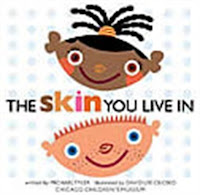As I previously mentioned talking with children and teenagers is a skill that can be improved over time. As I wrote in other posts, some parents might be tempted to avoid certain topics as these force the parents to question the right moment, age and situation to discuss them.
I've already written on the blog about some common subjects such as sexuality, jealousy, lying, adoption, disability, money, drugs and Alzheimer. I invite you to take a look at these posts and, if you wish, send me a message with your question, since answering them might helpt others in similar situation.
Perhaps talking about racial differences can be easy, even common, for your family; for others, not so much. But how can talk about this subject with children?
Talking with a four-year-old is different than talking with an eight-year-old, since the words and vocabulary required vary. One good advice is to talk about the differences in general, showing them that racial differences are only one among many.
Debating social, racial and even cultural representativeness is part of our dayly lives, and nothing more fair than to take advantage of these moments to talk with your children.
It's important to remember that the child is not born with internalized concepts, for example, prejudice. So we need to identify when that behavior manifests itself and the best way to approach it. At this point the adult needs to be careful not to pass on his preconceptions to the child.
A good example is when a child comments about another child skin color, for example. Don't be angry or try to make the child stop talking. Try to understand the reason behind the words and why. Take their the comments and questions seriously.
To help talking about this and to make it more natural, I will suggest some books that touch this subject. (Books in Portuguese will be suggested in the Portuguese blog, click here and check out)
In this acclaimed book, the author of the Newbery Honor Book To Be a Slave shares his own story as he explores what makes each of us special. Karen Barbour's dramatic, vibrant paintings speak to the heart of Lester's unique vision, truly a celebration of all of us.
'The Skin you live in', writen by Michael Tyler in 2005, this lively story delivers an important message of social acceptance to young readers. Themes associated with child development and social harmony, such as friendship, acceptance, self-esteem, and diversity are promoted in simple and straightforward prose. Vivid illustrations of children's activities for all cultures, such as swimming in the ocean, hugging, catching butterflies, and eating birthday cake are also provided. This delightful picturebook offers a wonderful venue through which parents and teachers can discuss important social concepts with their children.
' The Color of Us', writen by Karen Katz in 2002, tell a history about a seven-year-old Lena is going to paint a picture of herself. She wants to use brown paint for her skin. But when she and her mother take a walk through the neighborhood, Lena learns that brown comes in many different shades. Through the eyes of a little girl who begins to see her familiar world in a new way, this book celebrates the differences and similarities that connect all people.
See you next time,
Laura




No comments:
Post a Comment